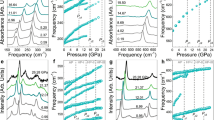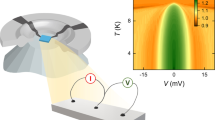Abstract
A diamond anvil cell is used to investigate the effect of high pressure (up to 37.5 GPa) on the optical absorption spectra of a single crystal of nickel oxide (NiO). In addition, strain-gage measurements are used to experimentally investigate the V(P) equation of state at a hydrostatic pressure of up to 8.5 GPa in a high-pressure chamber of the “toroid” type. Measurements are performed at room temperature. Absorption bands are observed, which correspond to optical d-d transitions of Ni2+ ion in the crystal field of ligands 3A2g → 3T2g, 3A2g → {au1}E1g, 3A2g → 3T1g(F), and 3A2g → 1T2g. The values of energy of these transitions increase linearly with pressure, and their pressure coefficients are 7.3 ± 0.2, 2.87 ± 0.9, 9.7 ± 0.5, and 8.9 ± 0.3 meV/GPa, respectively. The pressure derivative of the crystal field parameter 10Dq corresponding to the 3A2g → 3T2g transition gives the pressure dependence of the magnitude of exchange integral J in the Anderson hybridization model. It is found that, in the pressure range from zero to 37.5 GPa, the behavior of the exchange integral J is largely defined by the hybridization parameter b = (10Dq/3). At the same time, the Coulomb interaction parameter Ueff is independent of pressure and, therefore, has no effect on the variation of J. The Coulomb interaction Ueff ≈ 7.47 ± 0.005 eV is determined. The experimental data on the equation of state are used to derive the \(J \propto V^\varepsilon \) correlation, where ε = −2.99 ± 0.15, which is in good agreement with the predictions of Bloch’s theory (ε = −10/3).
Similar content being viewed by others
References
G. A. Slack, J. Appl. Phys. 31, 1571 (1960).
N. F. Mott, Proc. Phys. Soc. London, Sec. A 62, 416 (1949); Can. J. Phys. 34, 287 (1961); Metal-insulator Transitions (Taylor and Francis, London, 1990).
J. Zaanen, G. A. Sawatsky, and J. W. Allen, Phys. Rev. Lett. 55, 418 (1985).
V. I. Anisimov, J. Zaanen, and O. K. Andersen, Phys. Rev. B 44, 943 (1991).
S. Hufner, J. Osterwalder, T. Riesterer, and F. Hulliger, Solid State Commun. 52, 793 (1984).
T. Eto, S. Endo, M. Imai, et al., Phys. Rev. B 61, 14984 (2000).
R. Newman and R. M. Chrenko, Phys. Rev. 114, 1507 (1959).
L. G. Khvostantsev, L. F. Vereshchagin, and A. P. Novikov, High Temp.-High Press. 9, 637 (1977).
O. B. Tsiok, V. V. Bredikhin, V. A. Sidorov, and L. G. Khvostantsev, High Press. Res. 10, 523 (1992).
R. L. Clendenen and H. G. Drickamer, J. Chem. Phys. 44, 4223 (1966).
E. Huang, High Press. Res. 13, 307 (1995).
J. Wang, E. S. Fisher, and M. H. Manghnani, Chin. Phys. Lett. 8, 153 (1991).
D. R. Stephens and H. G. Drickamer, J. Chem. Phys. 34, 937 (1961).
Zheng Wen-Chen, Li Wei, and Wu Shao-Yi, Phys. Status Solidi A 173, 437 (1999).
D. T. Sviridov, R. K. Sviridova, and Yu. F. Smirnov, Optical Spectra of Transition Metals in Crystals (Nauka, Moscow, 1976), p. 239.
P. W. Anderson, Phys. Rev. 115, 2 (1959); Solid State Phys. 14, 99 (1963).
M. T. Hutchings and E. J. Samuelsen, Phys. Rev. B 6, 344 (1972).
M. J. Massey, N. H. Chen, J. W. Allen, and R. Merlin, Phys. Rev. B 42, 8776 (1990).
V. A. Sidorov, Appl. Phys. Lett. 72, 2174 (1998).
D. Bloch, J. Phys. Chem. Solids 27, 881 (1966).
Author information
Authors and Affiliations
Corresponding author
Additional information
__________
Translated from Zhurnal Éksperimental’noĭ i Teoreticheskoĭ Fiziki, Vol. 119, No. 4, 2001, pp. 799–804.
Original Russian Text Copyright © 2001 by Gavrilyuk, Troyan, Lyubutin, Sidorov.
Rights and permissions
About this article
Cite this article
Gavrilyuk, A.G., Troyan, I.A., Lyubutin, I.S. et al. The effect of high pressure on the structure and on the magnetic and electronic properties of nickel monoxide. J Exp Theor Phys 92, 696–700 (2001). https://doi.org/10.1134/1.1371350
Received:
Published:
Issue Date:
DOI: https://doi.org/10.1134/1.1371350




